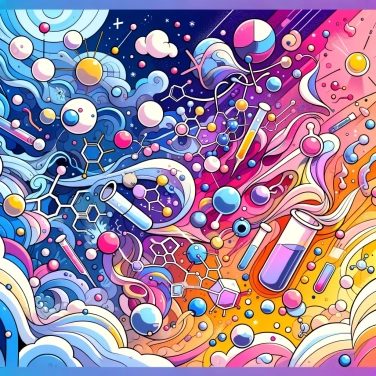Fireworks explode in colors thanks to the various metallic salts added to the explosive mixtures. Each metallic salt produces a specific color when heated by the chemical reaction of the explosion.

The intense colors of fireworks primarily come from the phenomenon of chemical combustion. When the fireworks explode, they release a very strong energy in the form of heat. This heat excites the atoms of the chemical elements present, particularly those of metallic salts. Once excited, the electrons of the atoms jump to higher energy levels, but since these electrons do not like to remain unstable, they quickly return to their initial state. As they return to their positions, they release the accumulated energy in the form of visible light: each element releases a specific wavelength, in other words, a particular color. That’s why we get this impressive variety of bright colors during fireworks displays.
The vibrant colors of fireworks primarily depend on the metallic salts used. When heated, each metal emits a specific luminous color: for example, sodium produces a beautiful orange-yellow, copper releases an intense blue light, and strontium offers a nice bright red. The secret lies in these metallic salts which, under intense heat, excite their electrons. As soon as they return to their initial state, they release energy in the form of colored light. Therefore, each metal has its own luminous "signature," allowing pyrotechnicians to create super precise colorful explosions.
When heating the metal salts of fireworks, their electrons absorb energy and jump to a higher level. When these electrons return to their initial state, they release energy in the form of light. Each metal has its own specific electronic energy levels. As a result, electrons always emit precise colors, corresponding to a sort of visual fingerprint unique to each element: its light spectrum. For example, copper gives that characteristic blue-green hue, while sodium consistently appears as a beautiful yellow-orange. That’s how a fireworks technician can precisely choose their metal based on the final result they want to achieve in the sky.
To change the nuances of colors, the simplest way is to play with the proportions of metallic salts that you add. A little more copper, for example, and you easily transition from blue-green to a deep blue. Mixing several salts can also create original shades: calcium and strontium together produce reds that gently shift to orange. It is also possible to control the hues by the size and shape of the metallic salt particles. The finer the grains, the better the combustion, which generates a hotter flame and thus a very bright color. The choice of oxidizer also influences the heat obtained, and therefore the final shade. Ultimately, by manipulating the precise chemical composition and exact proportions, it's a true pyrotechnic artist's game to achieve the perfect color at the right moment.
Each chemical element used in a firework produces a specific color: sodium gives a bright yellow flame, strontium a deep red flame, and barium an intense green flame.
Blue is one of the most difficult colors to produce in fireworks: it requires very specific copper compounds and a carefully controlled temperature during combustion.
A typical firework rocket can reach speeds of 250 to 350 kilometers per hour before producing its colorful bursts in the sky.
In the Middle Ages, fireworks were primarily white or golden, as the techniques for creating other colors using metal salts had not yet been mastered.
Almost all visible colors can be created using certain chemical elements, but some are easier to achieve than others. Bright deep blue, for example, is notoriously difficult to obtain, requiring very precise temperature and chemistry.
Yes, there are so-called silent or low-noise fireworks. These use light effects and specific chemical combinations to significantly reduce, or even eliminate, the noise of explosions without diminishing the visual display.
Light travels much faster than sound (about 300,000 km/s for light compared to about 343 m/s for sound in air). Thus, we perceive the light from fireworks first, and the sound reaches our ears only a few seconds later.
Each metal present in metallic salts has a specific electronic structure. When heated, their electrons absorb and then release energy in the form of light at precise wavelengths, producing different characteristic colors.
Fireworks do indeed release chemical elements into the atmosphere. Some compounds present in fireworks can have limited environmental consequences, particularly concerning air and water quality. However, there are now more eco-friendly fireworks that use less polluting materials.

0% of respondents passed this quiz completely!
Question 1/5